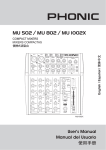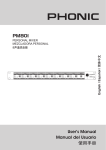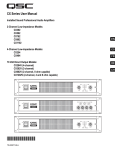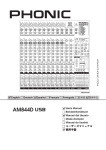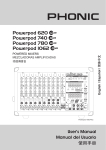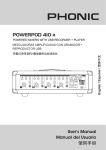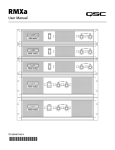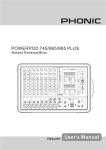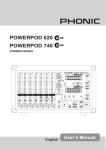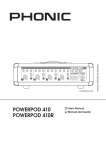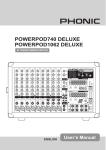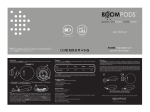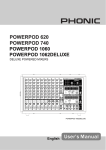Download Powerpod 620 R Powerpod 740 R
Transcript
POWERED MIXERS WITH USB RECORDER + PLAYER Mezcladoras Amplificadas con Grabador + Reproductor USB 内置USB录音机+播放器的功放调音台 Powerpod 740 R User’s Manual Manual del Usuario 使用手册 English / Español / 简体中文 Powerpod 620 R Powerpod 740 R Powerpod 620 R Powerpod 740 R POWERED MIXERS WITH USB RECORDER + PLAYER Mezcladoras Amplificadas con Grabador + Reproductor USB 内置USB录音机+播放器的功放调音台 CONTENTS CONTENIDO 目录 INTRODUCTION 4 INTRODUCCION 14 简介................................25 FEATURES 4 CARACTERISTICAS 14 功能................................25 BASIC SETUP 4 CONFIGURACION BASICA 15 基本安装........................25 MAKING CONNECTIONS 5 HACIENDO CONEXIONES 16 连接设定........................26 CONTROLS AND SETTINGS 7 CONTROLES Y SETEOS 18 控制与设定.....................27 Powerpod USB Recorder10 Powerpod USB Recorder 21 Powerpod USB录音机 30 SPECIFICATIONS 11 ESPECIFICACIONES 22 规格................................31 DIGITAL EFFECTS TABLE 33 TABLA DE EFECTOS DIGTALES 33 数字效果表.....................33 APPLICATIONS 34 APLICACIONES 34 应用................................34 DIMENSIONS 36 DIMENSIONES 36 尺寸................................36 BLOCK DIAGRAMS 37 DIAGRAMAS DE BLOQUE 37 线路图 37 Phonic preserves the right to improve or alter any information within this document without prior notice Phonic se reserva el derecho de mejorar o alterar cualquier información provista dentro de este documento sin previo aviso PHONIC保留不预先通知即可更新本手册的权利 V1.0 4/4/2010 IMPORTANT SAFETY INSTRUCTIONS The apparatus shall not be exposed to dripping or splashing and that no objects with liquids, such as vases, shall be placed on the apparatus. The MAInS plug is used as the disconnect device, the disconnect device shall remain readily operable. warning: the user shall not place this apparatus in the can be easily accessible. area during the operation so that the mains switch 1. Read these instructions before operating this apparatus. CAUTION 2. Keep these instructions for future reference. RISK OF ELECTRIC SHOCK DO NOT OPEN 3. Heed all warnings to ensure safe operation. 4. follow all instructions provided in this document. 5. Do not use this apparatus near water or in locations where condensation may occur. 6. Clean only with dry cloth. Do not use aerosol or liquid cleaners. Unplug this apparatus before cleaning. 7. Do not block any of the ventilation openings. Install in accordance with the manufacturer’s instructions. 8. Do not install near any heat sources such as radiators, heat registers, stoves, or other apparatus (including . . Do not defeat the safety purpose of the polarized or grounding-type plug. A polarized plug has two blades with one wider than the other. A grounding type plug has two blades and a third grounding prong. The wide blade or the third prong is provided for your safety. If the provided plug does not into your outlet, consult an electrician for replacement of the obsolete outlet. 10. Protect the power cord from being walked on or pinched particularly at plug, convenience receptacles, and the point where they exit from the apparatus. 11. Only use attachments/accessories manufacturer. by the 12. Use only with a cart, stand, tripod, bracket, or table by the manufacturer, or sold with the apparatus. When a cart is used, use caution when moving the cart/apparatus combination to avoid injury from tipover. 13. Unplug this apparatus during lighting storms or when unused for long periods of time. 14. Refer all servicing to service personnel. Servicing is required when the apparatus has been damaged in any way, such as power-supply cord or plug is damaged, liquid has been spilled or objects have fallen into the apparatus, the apparatus has been exposed to rain or moisture, does not operate normally, or has been dropped. CAUTIOn: TO REDUCE THE RISK Of ELECTRIC SHOCK, DO nOT REMOVE COVER (OR BACK) nO USER SERVICEABLE PARTS InSIDE REfER SERVICInG TO QUALIfIED PERSOnnEL The lightning flash with arrowhead symbol, within an equilateral triangle, is intended to alert the user to the presence of uninsulated “dangerous voltage” within the product’ magnitude to constitute a risk of electric shock to persons. The exclamation point within an equilateral triangle is intended to alert the user to the presence of important operating and maintenance (servicing) instructions in the literature accompanying the appliance. wARNING: To reduce the risk of or electric shock, do not expose this apparatus to rain or moisture. CAUTION: Use of controls or adjustments or performance of procedures other than those may result in hazardous radiation exposure. INTRODUCTION 7 balanced mic inputs through XLR jacks Phonic Corporation would like to congratulate you on the purchase of one of their extraordinary Powerpod ‘R’ mixers, powered mixers that provide a built-in USB recorder and playback device. Since its introduction, the entire Powerpod series has given other powered mixer lines a run for their money. With fantastically low noise levels, high signal handling abilities, exceptional output levels, simplified signal routing abilities, and ultra-smooth controls, the Powerpod 620 R and Powerpod 740 R both provide a level of dependability not often found in powered mixers as of late. 2 Super Hi-Z inputs optimized for direct input of high impedance instruments The built-in USB recorder provides a means to record lossless WAV-format audio directly to any USB memory stick. Recording directly from the main mix (pre-fader), the Powerpod R’s recordings are sampled at 44.1 kHz (the same sampling rate used on compact discs) and can be later edited and tweaked on any modern computer. The recorder also enables playback of WAV and MP3 files directly from a USB memory stick, the audio of which is sent directly to the main mix. We know how eager you are to get started – getting the mixer out and hooking all your gear up is probably your number one priority right now – but before you do, we strongly urge you to take a look through this manual. Inside, you will find important facts and figures on the set up, use and applications of your brand new mixer. If you do happen to be one of the many people who flatly refuse to read user manuals, then we just urge you to at least glance at the Basic Setup section. After glancing at or reading through the manual (we applaud you if you do read the entire manual), please store it in a place that is easy for you to find, because chances are there’s something you missed the first time around. FEATURES Powerpod 620 R 100W + 100W / 4 ohms amplifier for Main 1 / Main 2 or Main / Monitor (Bridge mono, 200W / 8 ohms) 10 line inputs through 1/4" jacks 2 built-in limiters 3-band channel EQ Pad control on channels 1 to 4 Monitor and effect sends on each input channel 1 AUX input +48V phantom power on channels 1 through 4 Record output with trim control for recording level matching Mains power switchable between 115VAC and 230VAC BASIC SETUP Getting Started 1. Turn all power off on the Powerpod mixer. To ensure this, the AC cable should not be connected to the unit. 2. All faders and level controls should be set at the lowest level to ensure no sound is inadvertently sent through the outputs when the device is switched on. All levels should be altered to acceptable degrees after the device is turned on. 3. Plug all necessary instruments and equipment into the device’s various inputs as required. This may include line signal devices, as well as microphones and/or guitars, keyboards, etc. 4. Plug any necessary equipment into the device’s various outputs. This could include speakers, monitors, signal processors, and/or recording devices. NB. No devices other than speakers should be connected to the power amp outputs. Plugging inappropriate devices into the mixer will likely cause damage to the device. Also, guitar cables should not be used to connect amplifiers to speakers. Onboard USB recorder allows recording and playback directly to and from a USB memory stick 5. Plug the supplied AC cable into the AC inlet on the back of the Powerpod, ensuring the local voltage level is identical to that selected using the voltage selector on the rear of your device. 32/40-bit digital stereo multi-effect processor with 16 programs plus foot switch jack 6. Use the supplied AC cable to connect to an AC power outlet of a suitable voltage. Stereo 7-band graphic equalizers 7. Turn the power switch on. 6 balanced mic inputs through XLR jacks 8 line inputs through 1/4" jacks 2 Super Hi-Z inputs optimized for direct input of high impedance instruments 2-band EQ on all channels Pad control on channels 1 to 4 Monitor and effect sends on each input channel 1 AUX input +48V phantom power on channels 1 through 4 Record output with trim control for recording level matching Powerpod 740 R 220W + 220W / 4 ohms amplifier for Main 1 / Main 2 or Main / Monitor (Bridge mono, 440W / 8 ohms) Onboard USB recorder allows recording and playback directly to and from a USB memory stick 32/40-bit digital stereo multi-effect processor with 16 programs plus foot switch jack Dual 7-band graphic equalizers for Main/Monitor or Main1/Main2 with In/Out switches Channel Setup 1. To ensure the correct audio levels of each input channel is selected, every channel faders should first be set to 0. 2. Choose the channel that you wish to set the level of, and ensure that channel has a signal sent to it similar to the signal that will be sent when in common use. For example, if the channel is using a microphone, then you should speak or sing at the same level the performer normally would during a performance. If a guitar is plugged into that channel, then the guitar should also be used as it normally would be. NB. It is probably best to have nothing plugged into channels which are not being set, just to ensure no signal is inadvertently sent through the channel. 3. Set the channel level control to a level that would allow the meters (on the left of the Powerpod) to sit around the 0 dB mark. You may also have to activate phantom power or the PAD button to ensure the signal is an appropriate level. 4. This channel is now ready to be used; you can stop making the audio signal. 5. You should now select the next channel to set and go back to follow steps 1 through 4 for other instruments. POWERPOD 620 R / POWERPOD 740 R MAKING CONNECTIONS Master Section Channel Inputs The Powerpod 620 R and Powerpod 740 R supply various numbers input channels. The 620 R features a total of 6 channels, 2 of which accept stereo signals. The 740 R, on the other hand, features a total of 7 input channels, 3 of which accept stereo signals. Stereo signals accepted by these powered mixers are summed for the main mix, as these mixers are ‘dual mono’ rather than stereo. 1. XLR Lo-Z and Mic Inputs These XLR microphone inputs can be used in conjunction with a wide range of microphones, such as professional condenser, dynamic or ribbon microphones, with standard XLR male connectors. With low noise preamplifiers, these inputs serve for crystal clear sound replication. Phantom power can be applied on channels 1 through 4. NB. When using an unbalanced microphone, please ensure phantom power is switched off. However, when using condenser microphones the phantom power should be activated. 2. 1/4” Hi-Z and Super Hi-Z Input Jacks These inputs accept typical 1/4” TRS or TS unbalanced inputs. The Hi-Z inputs accept balanced TRS inputs, and are for Microphone to line-level device (such as synthesizers and drum machines), where the Super Hi-Z inputs accept TS unbalanced sources, and can be used in conjunction with devices with higher impedance levels (including electric guitars and basses). The Powerpod 620 R and Powerpod 740 R feature a number of input and output methods, depending on what your setup requires. RCA record outputs, tape inputs, 1/4” auxiliary inputs and monitor outputs are included – amongst a range of other connection possibilities. 4. Tape Inputs (L and R) The first of these inputs accommodates RCA cables from such devices as tape and CD players. The line from this feed is controlled by the Tape In level control, before being fed through to the main mix. 5. Record Outputs (L and R) As with the Tape In ports, these outputs will accommodate RCA cables, able to be fed to a variety of recording devices. The record output is taken directly from the main mix. A trim control is featured on these outputs to accommodate for devices with different recording levels. 6. AUX Inputs This TS input connects the mixer with parallel external devices, such as sub mixers or external effect processors, receiving the processed signal from another source and feeding it to the AUX mixing buses. NB. When using a line-level device through the Hi-Z and super Hi-Z inputs, the PAD -25 button should be initiated. 3. Stereo Channel Inputs Each of the Powerpod 740 R provides 3 stereo input connectors, while the Powerpod 620 R has 2. The inputs of these channels differ slightly to the mono channels. The 3-pin XLR inputs featured are for the addition of microphones with typical XLR male inputs, where the 2 Line 1/4" TS jacks are for the addition of various stereo line level input devices, such as keyboards. If you wish to use a mono device on a stereo return input, simply plug the device’s 1/4" phone jack into either of the input connectors and leave the other input bare. 6 7. 3 1 5 Monitor Outputs These 1/4” TS outputs are the final output from the Monitor send mixing bus. This feed may be used to connect to an amplifier and speaker. Feeding the output from the Monitor out to an amplifier (and possibly an equalizer) and then to a floor monitor speaker allows artists to monitor their own instruments or vocals whilst performing, or an engineer to monitor the mix. 8. 2 4 Main Outputs This jack will output the final stereo line level signal sent from the main mixing bus. The primary purpose of these jacks is to send the Main output to external devices that may run in parallel with the mixer. This may include additional power amplifiers, mixers, PA systems, as well as a wide range of other possible signal processors. 8 7 POWERPOD 620 R / POWERPOD 740 R 9. EFX (Effect) Outputs These 1/4” TS outputs are the final output from the EFX send mix. This feed may be used to connect to an external digital effect processor, or even to an amplifier and speakers, depending on your desired settings. SPE A K ER SETUP 10 Not used 10. Foot Switch Jack This port is for the inclusion of a non-latching foot switch, used to remotely adjust properties of the built-in Digital Effect processor. The Powerpods 620 R and 740 R both feature a single foot switch jack, which allows the user to remotely turn on and off the digital effects. Rear Panel 11. Speaker Outputs These jacks are used to connect to speakers, fed from the internal power amp. They consist of 1/4" Phone Jacks on both models. The Amp Select switch (on the front of the mixer) determines the operation of these jacks. If the Amp Select switch is set to "Main 1/Main2" or "Main / Moni", a single speaker with a 4 to 8 ohm load can be connected to jack A on both the Main 1 and Main 2 speaker outputs. You can also connect two speakers with impedances between 8 and 16 ohms to both jacks A and B of the Main 1/2 speaker outputs. When using Bridge Mono mode, use the Speaker Output labeled "Bridge (L+R)" only to connect a Speaker with a loading between 8 and 16 ohms. Refer to the Speaker set up chart to the right for a more detailed indication of how to connect speakers. Not used NB. Due to the fact that the signal has been processed by the power amp, these ports should be used in conjunction with passive speakers only to avoid damaging any other equipment. 11 Not used Not used Using speakers with an incorrect loading can not only cause distortion, but also irreversible damage to the powered mixer. Please ensure the loadings of your speakers are consistent with those shown above. POWERPOD 620 R / POWERPOD 740 R CONTROLS AND SETTINGS Rear Panel 14 12. Power Button and AC Connector The power button, located on the rear of the mixer, is used to activate the mixer. Of course, there’s no point in activating the mixer if there’s no power, therefore an AC connector has been included to ensure your mixer gets the power it needs. Please use the power cable that is included with this mixer only. The Powerpod 620 R offers a permanent power cable in lieu of an AC connector. 15 16 NB. Before connecting the AC cable to the Powerpod Mixer, please ensure the local voltage levels are identical to those chosen by the Voltage Selector switch. 17 18 13. Voltage Selector (Powerpod 740 R only) This switch allows you to select from 2 mains power modes, 115 VAC / 60 Hz (allowing you to use the device in Countries with voltages between 100V and 120V) or 230 VAC / 50 Hz (allowing you to use the device in Countries with voltages between 220V and 240V). To change the Voltage Selector, you must first unscrew and remove the plastic cover that protects the switch. After changing the voltage, please replace the plastic cover to ensure the voltage level is not inadvertently altered. The Powerpod 620 R’s power range is determined by the NB. Using incorrect voltages can cause irreversible damage to the mixer. All care must be taken in selecting the voltage appropriate to your zone. If unsure of local voltage levels, contact a knowledgeable source before using this mixer. 19 20 16. Low Frequency Control This control is used to give a shelving boost or cut of ±15 dB to low frequency (80 Hz) sounds. This will adjust the amount of bass included in the audio of the channel, and bring more warmth and punch to drums and bass. 17. MON (Monitor) Level Control This control alters the signal level that is being sent to the Monitor mixing buses, the signal of which is suitable for connecting stage monitors, allowing artists to listen to the music that is being playing. 12 13 Channel Controls 14. High Frequency Control This control is used to give a shelving boost or cut of ±15 dB to high frequency (12 kHz) sounds. This will adjust the amount of treble included in the audio of the channel, adding strength and crispness to sounds such as guitars, cymbals, and synthesizers. 15. Middle Frequency Control (Powerpods 740 R only) This control is used to provide a peaking style of boost and cut to the level of middle frequency sounds at a range of ±15 dB. Changing middle frequencies of an audio feed can be rather difficult when used in a professional audio mix, as it may be more desirable to cut middle frequency sounds rather than boost them, soothing overly harsh vocal and instrument sounds in the audio. POWERPOD 620 R / POWERPOD 740 R 18. EFX (Effect) Level Control This control alters the signal level that is sent to the EFX output, which can be used in conjunction with external signal processors (this signal of which can be returned to mixer via the stereo return inputs), or simply as additional auxiliary outputs for any means required. These controls also adjust the level of audio that is sent to the built-in digital effect panel. 19. Channel Level Control This control will alter the signal level that is sent from the corresponding channel to the Main mixing bus. 20. PAD -25 Button The PAD -25 button, located above the 1/4” phone jack on mono channels, is used to attenuate the input signal by 25 dB. This should only be pushed in when using line-level input devices. Digital Effect Processor 28. Play/Pause Button 21. Effects On Button (Powerpods, 740R only) Pushing this button will turn the built-in effect processor on and off. 22. Program Control This control will allow users to select one of the 16 built-in digital effects of the Powerpod powered mixer. The effect names that correspond with the numbers can be found above this control, or details can be found in the digital effect table. 23. Parameter Control Turning this control will adjust the one main parameter of the selected effect. Each effect’s parameter can be found on the digital effect table at the end of this manual. 22 21 23 USB Recorder The USB Recorder’s source signal is taken directly from the main mix prior to it being cut/boosted by the Main level control. While the recordings are indeed in stereo, they are also limited by the Powerpod 620 R and Powerpod 740 R’s circuitry, which is dualmono rather than stereo. When playing back a signal, the signal will pass through the USB trim control and then is sent directly to the main mix. Playback of WAV and MP3 with bit rates of up to 320 kbits per second is possible. 24. Display This 3-digit display will display the track number currently being played. It also offers play, pause and record indicators to the left of the display. When in playback mode, the screen will indicate the type of file type the unit is currently playing: WAV or MP3. 25. USB Port Connect your USB flash drive to this input. Once a drive is connected, the files will initiate and the first track will appear paused on screen. 26. Record Button Push this button to start recording mode. When recording mode is initiated, the next available track number (after any previously recorded tracks) will appear on screen and recording mode will be initiated in pause. Push the Play/Pause button to start recording. Recording is only possible when an appropriate USB memory card is inserted into the USB port. 27. Back/Next Buttons Pushing these buttons will allow users to skip back and forwards between tracks in sequence. Please note that these buttons cannot be held down to fast-forward/rewind through tracks. Push this button to start and stop playback and recording of the currently displayed track. Starting a track after it is paused will resume the track from the point at which it was paused (in both record and playback mode). When in recording mode, push and hold this button to finalize recordings. When in playback mode, pushing and holding this button will revert back to the first track on the USB memory stick. 29. USB Trim Control This level control adjusts the playback level sent from the USB recorder’s playback function to the main mix. Users are advised to format their USB memory sticks with the FAT-32 file system. Master Section 30. EFX to Monitor Control This controls the level of the processed signal from the built-in effect processor that is sent to the Monitor mix. 31. EFX to Main Control This controls the level of the processed signal from the built-in effect processor that is sent to the Main 1/2 mix. 32. AUX In Control The AUX in control adjusts the final level of the AUX input that is sent to the Main mix. 33. Tape In Control The Powerpod 620 R features a Tape In control that adjusts the final level of the RCA Tape input that is sent to the Main mix. The Powerpod 740 R features two such controls, one underneath each of its equalizers; the uppermost control adjusts the Tape input signal sent to the Monitor mix, whereas the lower control adjusts the signal sent to the Main mix. 34. Graphic Equalizers These graphic equalizers allow you to adjust the frequency response of a signal, with a maximum of ±12 dB of signal boost or cut for each of the frequencies. The Powepods 740 R features dual 7-band graphic equalizers, while the Powerpod 620 R features a single stereo 7-band graphic equalizer for both the Main and Monitor signals. The uppermost equalizer is for alteration of the Monitor signal (when the EQ switch is in the appropriate position it becomes the Main 2 EQ), where the lower equalizer is for the Main signal (or the Main 1). 30 36 31 27 26 34 28 24 25 29 35 32 33 POWERPOD 620 R / POWERPOD 740 R 35. EQ IN and Indicator (Powerpods 740R only) 30 This button activates the graphic equalizer in which it accompanies. The corresponding LED indicator illuminates when the EQ is activated. 36. EQ Select Switch (Powerpods 740 R only) This switch (featured on the Powerpods 740 R only) enables you to select the way you utilize the pair of Equalizers on these models. When the switch is in the uppermost position it enables you to use the top equalizer for the Monitor signal, and the bottom equalizer for the Main signal; the lower position allows the equalizers to each be used for the mixer’s Main 1 and 2 signals. 36 31 34 37. Phantom Power Switch and Indicator When this switch is in the on position it activates +48V of phantom power for the XLR inputs on channels 1 to 4, allowing condenser microphones to be used on these channels. The corresponding LED will illuminate when phantom power is activated. 35 38. Amp Select Switches 32 This switches control the activity of the built-in power amp, enabling the user to alternate between the different signals which can be processed by the built-in power amp and routed to the speaker outputs on the rear of the device. This switch allows you to select from: Main/Monitor – taking the monitor and main signals and directing them to the appropriate speaker outputs; Main 1 / Main 2 – using the Main signal to feed the speaker outputs; and Bridge – which combines the amplifiers’ power and feeds it through the Bridge output only. NB. When using a mono bridge connection, do not connect a speaker to any of the Main/Monitor A or B jacks, located on the rear of the mixer. Use the "Bridge" speaker jack only. 33 43 37 39. Monitor Level Control This rotary control allows the user to adjust the final signal level sent to all Monitor outputs. 40. Main Level Control 39 This rotary control allows the user to adjust the final signal level sent to the Main and Speaker outputs. 42 41. Level Meter 41 These level meters give accurate indications of when audio levels of the Main and Monitor outputs reach certain levels. The 0 dB indicator illuminates is approximately equal to an output level of +4 dBu. It is suggested that users set the various level controls so that it sits steadily between 0 and +3 (+6 on the 740 R). This will make full use of audio while still maintaining fantastic clarity. The Powerpod 620 R features a single dual 5-segment LED display, while the Powerpod 740 R features two single 5-segment LED displays – one for each the monitor and main signals. 42. Limiters (Powerpods 740 R only) These LED indicators illuminate when the power amplifier’s built-in limiters are activated, which effectively reduce signal levels when they reach high levels that could prove to damage sound quality. 40 38 43. Power Indicator This LED indicator illuminates when power of your Powerpod mixer is activated. POWERPOD 620 R / POWERPOD 740 R Powerpod USB Recorder Play Record 1. When you first turn the Powerpod on, the USB recorder’s display will show the word ‘ON’ 1. When a USB disc is inserted, push the REC button to activate record mode. 2. Insert an appropriately formatted (FAT32) USB flash disc. 2. The screen will immediately display WAV (as the recording format) and then the next available track number will appear on screen. For example, if there are 12 WAV files on the USB card, the screen will display “II/REC 013”. 3. The USB recorder will indicate the file type about to be played (MP3 or WAV) and automatically find the first available track. The screen will then indicate “II 001”. Tracks are ordered alphanumerically, with MP3 files playing first, followed by WAV files. 3. Record mode will begin in standby/pause. Push the Play/Pause button to begin recording. 4. Press the Play/Pause button to play the current track, or the Back and Next buttons to skip forward and backwards between tracks. 4. Push the Play/Pause button to pause recording. Pushing the Play/Pause button again will resume recording from the position at which it was paused. 5. If you are currently playing the final MP3 file on the USB disc, pushing the >>| button will skip to the first WAV track. Similarly, if the final WAV track is playing, pushing >>| will skip back to the first MP3 track. 5. While recording, push the REC button to finalize the recording the current track and cue the next track for recording. For example, if you are currently recording track 13, pushing the REC button will finalize the WAV file recorded for track 13, and the screen will display “II/REC 014” with recording on track 14 set to standby. 6. Playback on the USB recorder is set to continuously playback audio files, therefore pushing play will play all files in sequence. Once all files have played, they will then be repeated. 7. When in play or pause mode, pushing and holding the Play/ Pause button for 2 seconds will revert to the very first track on the USB disc. 6. Hold the Play/Pause button to finalize the recording and return to playback mode. 7. After finalizing your recording, playback mode will start on the first MP3 track. In this case, push the Back button once to access the final WAV recording – in other words, the recording you just finalized. NOTE: The USB rotary control will adjust the playback level only and will not affect recording levels. The only level controls that will affect the recording level are those found on the individual input channels. The optimal frequency range for recording on the Powerpod 620 R and Powerpod 740 R USB recorder is 50 Hz to 10 kHz. This makes recordings ideal for band practice sessions, conferences, school assemblies and other events where informal recordings are necessary. For full-scale professional recordings, Phonic recommends the Firefly and Helix Board digital recording interfaces for Mac and PC computers. These units come with FireWire and/or USB interfaces and are ideal for recording in any number of possible scenarios, from live gigs to studio recording sessions. Information on availability can be found through your nearest Phonic dealer. Log on to www.phonic.com/where for details. 10 POWERPOD 620 R / POWERPOD 740 R Specifications POWERPOD 620 R POWERPOD 740 R 2 2 N/A 2 8 ohms per Channel 70 145 4 ohms per Channel 100 220 8 ohms Bridge Mono 200 440 6, 2 with super Hi-Z (470K ohms) 4, 2 with super Hi-Z (470K ohms) Number of Power Channels Limiter Inputs / Outputs Lo-Z / Hi-Z Channels Balanced Mic/Dual Mono Line Channels 2 3 RCA RCA AUX Returns 1 x 1/4" TRS, Unbal. 1 x 1/4" TRS, Unbal. Main Mono 1 x 1/4" TRS, Unbal. 1 x 1/4" TRS, Unbal. Monitor Send 1 x 1/4" TRS, Unbal. 1 x 1/4" TRS, Unbal. EFX Send 1 x 1/4" TRS, Unbal. 1 x 1/4" TRS, Unbal. 2T Input Record Out RCA RCA Speaker Outputs 5 x 1/4" TRS 5 x 1/4" TRS USB Connector 1 x USB-A 1 x USB-A Master Section Monitor & AUX / EFX Send Masters Effects Return to Monitor Faders 2 2 N/A Yes Moni, Main (Rotary) Moni, Main (Rotary) 44.1 kHz 44.1 kHz USB Recorder/Player Record Sampling Rate Recording Format wav wav Maximum Playback Bitrate 320 kbit/s 320 kbit/s Supported Playback Formats wav, mp3 wav, mp3 Phantom Power Supply +48VDC +48VDC 32/40-bit Digital Effect Processor Foot Switch 16 programs 16 programs Digital effect mute: ON/OFF Digital effect mute: ON/OFF Built-in Graphic EQ Stereo 7-band 2 x 7-band Channel Equalization 2-band, ±15dB 3-band, ±15dB 80Hz 80Hz N/A 2.5KHz 12KHz 12KHz Low EQ Mid EQ Hi EQ Crosstalk (1KHz@0dBu, 20Hz to 20KHz bandwidth, channel in to main 1/2 outputs) Channel muted, other channels at unity Frequency Response at proper impedance load POWERPOD 620 R / POWERPOD 740 R N/A <-64dB +1/-3dB +0/-2dB 11 POWERPOD 620 R POWERPOD 740 R Noise: 20Hz to 20KHz bandwidth, IHF-A weighted, line inputs to main outputs, all channels assigned Master output, all fader down <-78dBu <-78dBu Power amp output, all fader down <-63dBu <-63dBu @50 watts, 4 ohms <0.12% @100 watts, 4 ohms <0.5% <0.06% <0.3% THD Power output, 1KHz, 20Hz to 20KHz Any output, 1KHz @ +14dBu, 20Hz to 20KHz, channel inputs CMRR (1 KHz @ -60dBu, Gain at maximum) Power Requirement Switching Power Supply Dimensions (WxHxD) Weight 12 80dB 80dB 100-120VAC, 220-240VAC, 50/60 Hz 100-120VAC, 220-240VAC, 50/60 Hz Region Dependant Voltage Selectable 470x260x275 mm (18.5"x10.24"x10.83") 475x280x280 mm (18.7"x11"x11") 12kg (26.4lbs) 15.5kg (34.1lbs) POWERPOD 620 R / POWERPOD 740 R INTRODUCCION CARACTERÍSTICAS Phonic Corp quiere felicitarle por su compra de una de las extraordinarias mezcladoras Powerpod “R” Mixers, mezcladoras amplificadas que proveen un grabador USB integrado y un dispositivo “playback”. Desde su introducción, la entera serie Powerpod ha dado otras líneas de mezcladora amplificada rentable. Con sorprendentes niveles bajos de ruido, altas habilidades de manejo de señal, niveles de salida extraordinarios, posibilidades de ruteo de señales mas sencillo y controles ultra suaves, la Powerpod 620 R y la Powerpod 740 R, proveen un nivel de confianza no encontrado en otras mezcladoras amplificadas en el mercado. Powerpod 620 R ● Amplificador de 100W + 100W / 4 ohms Amplificador para main 1 / main 2 o main / monitor (Bridge mono, 200W / 8ohms) El grabador USB integrado proporciona un medio para grabar audio sin pérdidas en formato WAV directamente a cualquier USB memory stick. Grabando directamente de la mezcla principal (prefader), las grabaciones de Powerpod R están a 44,1 kHz (el mismo índice de muestreo utilizado en los discos compactos) y pueden ser editadas y ajustadas posteriormente en cualquier computadora moderna. El grabador también permite la reproducción de archivos WAV y MP3 directamente desde un USB memory stick, cuyo audio se envía directamente a la mezcla principal. Nosotros sabemos que está impaciente por empezar- esperando a sacar la mezcladora y conectar todo que seguramente es su única prioridad en estos momentos - pero antes de hacerlo, le pedimos encarecidamente que darle un vistazo a este manual. Dentro encontrara hechos importantes con imágenes de la configuración, uso y aplicaciones de su nueva mezcladora. Si resulta ser de esas personas que se niega totalmente a leer los manuales, entonces solo le pediremos que lea la sección de Configuración Básica. Después de que le des un vistazo a todo el manual (le felicitamos si lee todo el manual), por favor guárdalo en un lugar donde pueda encontrarlo fácilmente, porque puede suceder que no recuerde algo de la primera vez que leyó este documento. ● El grabador USB a bordo permite grabar y reproducir directamente hacia y desde un USB memory stick. ● Procesador multi-efecto estéreo digital a 32/40-bits con 16 programas más interruptor de pedal (Jack) ● Ecualizadores gráficos estéreo de 7 bandas ● 6 entradas de micrófono balanceadas con jacks XLR ● 2 entradas de súper alta impedancia (Hi-Z) optimizadas para entrada directa de guitarras electroacústicas y guitarra eléctrica o bajos ● 2 limitadores integrados ● EQ de 2 bandas por canal ● Control de PAD en canales 1-4 ● Envíos de monitor y efecto en cada canal de entrada ● 1 entrada Aux ● Fuente Fantasma a +48V en los canales de 1 a 4 ● Salida de grabación con control de trim para igualar nivel de grabación Powerpod 740 Plus ● Amplificador de 220W + 220W / 4 ohms para main 1, main 2 / monitor (Bridge mono, 440W / 8ohms) ● Grabador USB integrado permitiendo la grabación y la reproducción directamente desde una llave USB ● Procesador multi-efecto estéreo digital a 32/40-bits con 16 programas más interruptor de pedal (Jack) ● Dual 7-band graphic equalizers for Main/Monitor or Main1/ Main2 with In/interruptor de salida ● 7 entradas balanceadas de micrófono a través de conectores (jacks) XLR ● 10 entradas de línea a través de jacks 1/4" ● 2 entradas Super Hi-Z optimizadas para entrada directa de instrumentos de alta impedancia. ● 2 limitadores integrados ● EQ de 3 bandas por canal ● Control de PAD en canales 1-4 ● Envíos de monitor y efecto en cada canal de entrada ● 1 entrada Aux ● Fuente Fantasma a +48V en los canales de 1 a 4 ● Salida de grabación con control de trim para igualar nivel de grabación ● Fuente de alimentación seleccionable entre 115VAC y 230VAC 14 POWERPOD 620 R / POWERPOD 740 R CONFIGURACION BASICA Iniciando Configuración de Canal 2. Todos los faders y controles de nivel deben estar seteados en el nivel más bajo para asegurarse que no se envía ningún sonido inadvertidamente a través de las salidas cuando se enciende el dispositivo. Todos los niveles deben ser alterados a los grados aceptables después de que se enciende el dispositivo. 2. Escoge el canal que quiera ajustar, y asegúrese de que cada canal tenga un nivel de señal de envío similar a la señal que será enviada en uso común. Por ejemplo, si el canal tiene un micrófono conectado, entonces hable o cante al micrófono al mismo nivel que el cantante usaría durante su presentación o grabación. Si se conecta una guitarra en ese canal, entonces la guitarra deberá tocarse al mismo nivel en que se tocaría normalmente. 1. Asegúrese de que todo el voltaje de la mezcladora esté apagado. Para asegurarse de esto, el cable de AC no debe de estar conectado a la unidad. 3. Conecte todos los instrumentos y equipo necesarios en las varias entradas del dispositivo como sea necesario. Esto puede incluir dispositivos de señal de línea, como micrófonos y/o guitarras, teclados, etc. 4. Conecte todo el equipo necesario en las varias salidas de dispositivo. Esto puede incluir altavoces, monitores, procesadores de señal y/o dispositivos de grabación. NB. Ningún otro dispositivo más que los altavoces deberán estar conectados a las salidas del amplificador. Conectar dispositivos inapropiados a esta mezcladora causará daños serios al dispositivo. Tampoco se deberán utilizar cables de guitarra para conectar los amplificador a los altavoces. 5. Conecte el cable de AC al conector trasero de dispositivo, asegúrese de que el nivel del voltaje local es idéntico al seleccionado en el Selector de Voltaje de la parte trasera de la unidad. 1. Para asegurar que se seleccionó el nivel de audio correcto para cada canal de entrada, cada fader de canal deberá setear primero a la posición 0. NB. Es mejor no tener nada conectado en los canales que no se estén ocupando, solo para asegurar que ninguna señal es enviada por error al canal. 3. Establece el nivel de control del canal de tal forma que permitirá a los medidores “meters” (en el lado izquierdo del Powerpod) de establecerse en los alrededores del nivel 0dB. Podría tener necesidad de activar el interruptor fantasma o el botón PAD para asegurarse de que la señal este en un nivel apropiado. 4. Este canal está ahora listo para usarse; ya puede dejar de hacer la prueba de audio. 5. Ahora deberá seleccionar el siguiente canal para ajustarlo y repetir los pasos del 1 al 4. 6. Conecte el cable de AC al toma corriente de voltaje compatible. 7. Encienda la unidad. POWERPOD 620 R / POWERPOD 740 R 15 HACIENDO CONEXIONES Sección Master Entradas de Canal Las mezcladoras Powerpod 620 R y Powerpod 780 R Plus ofrecen varios canales de entrada. La 620 R tiene un total de 6 canales, 2 de estos aceptan señales estéreo. La 740 R, por otro lado, tiene un total de 7 canales de entrada, 3 de estos aceptan señales estéreo. Las señales estéreo aceptadas por estas mezcladoras amplificadas se suman para la mezcla principal, ya que estas mezcladoras son “mono dual” en lugar de estéreo. 1. Entradas XLR de baja impedancia (Lo-Z) y entradas micrófono Estas entradas XLR de micrófono pueden ser utilizadas en conjunto con una amplia gama de micrófonos, tales como micrófonos profesionales de condensador, dinámicos o ribbon, con conectores macho estándar XLR. Con preamplificadores de bajo ruido, estas entradas sirven para reproducir sonido cristalino y limpio. La fuente fantasma puede estar aplicada entre los canales 1 a 4. NB. Cuando se utiliza un micrófono desbalanceado, por favor asegúrese de que la fuente fantasma esté apagada. Sin embargo, cuando se utiliza micrófonos de condensador, la fuente fantasma deberá ser activada. 2. Jacks de Entrada 1/4” de Alta Impedancia (Hi-Z) y Jacks de Súper Alta Impedancia (Súper Hi-Z) Estos conectores aceptan entradas típicas de 1/4” TRS o TS desbalanceada. Las entradas de Hi-Z aceptan entradas balanceadas TRS, y son para micrófonos a dispositivos de nivel de línea (como sintetizadores y drum machines), mientras que las entradas de Súper Hi-Z aceptan fuentes desbalanceadas TS y, pueden ser utilizadas en conjunto con dispositivos con niveles superiores de impedancia (incluyendo guitarras eléctricas y bajos). El Powerpod 620 R y el Powerpod 740 R disponen de un numero de entrada y un método de salida, dependiendo en que requiere su configuración. El grabador de salida RCA, entradas de cinta (tape inputs), 1/4" entradas auxiliares y salidas de monitor se incluyen en la gama de posibilidades de conexión 4. Entrada de Tape (L y R) Las primeras de estas entradas permiten cables RCA de aquellos dispositivos como reproductores de CD y tape. La línea de esta alimentación de esta entrada es dirigida por entrada de Tape en el nivel de control, antes de ser alimentada en la mezcla principal. 5. Salidas de Grabación (L y R) Así como en los puertos de entrada de Tape, estas salidas acomodaran a los cables RCA, capaz de alimentar una variedad de dispositivos de grabación. La grabación de salida esta cogida de la mezcla principal. Un controlador trim esta incluido en estas salidas para acomodar los dispositivos con diferentes niveles de grabación. 6. Entradas AUX Estas entradas TS conectan la mezcladora con los dispositivos externos paralelos, tales como sub mezcladoras o procesadores externos de efecto, recibiendo la señal procesada de otra fuente y alimentándola con los buses de mezcla AUX. NB. Cuando se utiliza un dispositivo de nivel de línea entre el HI-Z y el súper entrada HI-Z en la mezcladora, el selector PAD-25 deberá activarse. 3. Entradas de Canal Estéreo Cada una de las mezcladoras amplificadas Powerpod 740, R proveen de 3 canales estéreo de entrada (la Powerpod 620 Plus tiene 2), las entradas que difieren ligeramente de los canales mono. Las entradas XLR de 3 pines son para agregar micrófonos con conectores XLR machos típicos, mientras que los 2 jacks de línea 1/4” TS son para agregar varios dispositivos de entrada de nivel de línea estéreo, como teclados. Si usted desea utilizar un dispositivo monoaural en una entrada de retorno estéreo, simplemente conecte el jack de audífono de 1/4” con cualquiera de los dos conectores de entrada y deje el otro inutilizado. 6 4 5 7. Salidas de Monitor Estas salidas 1/4” TS son la salida final de envío Monitor de bus de mezcla. Esta alimentación puede ser utilizada para conectar a un amplificador y altavoces. Alimentar la señal de Monitor a un amplificador (y posiblemente un ecualizador) y de ahí a altavoz monitor de piso, permite a los artistas monitorear sus propios instrumentos o voces mientras hacen su presentación, o permite a un ingeniero monitorear la mezcla. 8. Salidas Principales 2 1 3 Estos jacks darán la salida estéreo final de nivel de línea, enviada desde el bus de mezcla principal. El propósito primario de estos jacks es el de enviar la salida principal a dispositivos externos que pueden funcionar en paralelo con la mezcladora. Esto puede incluir amplificadores de potencia adicionales, otras mezcladoras así como un amplio rango de otros posibles procesadores de señal. 8 7 16 POWERPOD 620 R / POWERPOD 740 R 9. Salida de EFX (Efectos) Estas salidas 1/4” TS son la salida final del bus de mezcla de envío de EFX. Esta alimentación puede ser utilizada para conectar a un procesador de efecto digital externo, o incluso a un amplificador y altavoces, dependiendo de su configuración deseada. Configuración de Altavoz 10. Jacks para interruptor de pedal Not used Estos puertos están para la inclusión de un interruptor pedal nolatch, usados para ajustar remotamente las características del procesador de Efecto Digital integrado. Las Powerpods R 620, Y Powerpods 740 Plus presentan un solo jack para interruptor pedal, que permite al usuario encender y apagar remotamente los efectos digitales. 10 Not used Panel de Dorso 11. Salidas de Altavoz Estos jacks son utilizados para conectar los altavoces, se alimentan del amplificador de potencia interno. Todos los modelos tienen Jacks de Audífono 1/4”. El selector de amplificación (situado delante de la mezcladora) determina la operación de estos jacks. Si el selector de amplificación está en “Main 1 / Main 2” o “main/moni” un solo altavoz con carga de 4 a 8 ohms puede ser conectado a Jack A a ambas Salidas de Altavoz Main 1 y Main 2-. Usted también puede conectar dos altavoces con impedancia entre 8 y 16 ohms a ambos jacks A y B de las Salidas de Altavoz izquierda y derecha (Main 1/2). Cuando se utilice en modo Bridge Mono, utilice la Salida de Altavoz etiquetada como “(L+R) Bridge” solo para conectar un altavoz con una carga entre 8 y 16 ohms. Refiérase a gráfico de configuración de altavoces para más indicación detallada sobre cómo conectar los altavoces. Not used Not used NB. Debido al hecho de que la señal ha sido procesada por el amplificador de potencia, estos puertos deberán de utilizarse en conjunto con los altavoces pasivos solo para evitar dañar cualquier otro equipo. 11 Utilizar altavoces con una carga incorrecta no solo podrá causar distorsión, también causará daños irreversibles a la mezcladora amplificada. Por favor asegúrese de que las cargas de los altavoces son consistentes a la señalada en este apartado. POWERPOD 620 R / POWERPOD 740 R 17 CONTROLES Y SETEOS Panel de Dorso 12. Botón de Energía y Conector de AC El botón de energía, localizado en la parte posterior de la mezcladora, es utilizado para activar la mezcladora. Por supuesto no tiene caso activarlo si la unidad no está conectada a la alimentación, por lo tanto un conector de AC ha sido incluido para asegurar que su mezcladora obtenga la energía que se necesita. Por favor utilice únicamente el cable de AC incluido con esta mezcladora. La Powerpod 620 R ofrece un cable de alimentación permanente, en lugar de un conector de corriente alterna 14 15 16 17 NB. Antes de conectar el cable de AC a la Mezcladora Powerpod, por favor asegúrese de que el voltaje local es idéntico al elegido por el Selector de Voltaje. 13. Selector de Voltaje Este interruptor permite a los usuarios seleccionar de dos modos de energía principales, 115VAC / 60 Hz (Le permite utilizar el dispositivo en países con voltajes entre 100V y 120V) o 230 VAC / 50 Hz (Le permite utilizar el dispositivo en países con voltajes entre 220V y 240V). Para cambiar el Selector de Voltaje, necesita primero destornillar y remover la cubierta plástica que proteje el interruptor. Después de cambiar el voltaje, por favor substituya la cubierta plástica para asegurarse que el nivel de voltaje no está alterado inadvertidamente. La gama de potencia 620 R Powerpod está determinado por el. NB. Utilizar voltajes incorrectos puede causar daños irreversibles a la mezcladora. Se deberá de tener todos los cuidados para que los voltajes sean adecuados. Si no está seguro de los niveles de voltaje local, contáctese con una fuente conocida antes de usar esta mezcladora. 18 19 20 16. Control LOW (Frecuencia Grave) Este control es utilizado para dar un realce tipo Shelving o un recorte de ±15dB a los sonidos de frecuencia baja (80 Hz). Esto ajustará la cantidad de graves incluidos en el audio del canal y, dará más calidez y punch a las baterías, guitarras bass e Issac Hayes. 17. Control de Nivel de MON (Monitor) Este control altera el nivel de señal que es enviado a buses de mezcla de Monitor, cuya señal es apta para conectar monitores de escenario, permitiendo a los artistas escuchar la música que se está ejecutando. 12 18. Control de Nivel de EFX (Efecto) 13 Controles de Canal 14. Control HF (Frecuencias Altas) Este control es utilizado para dar un realce tipo Shelving o un recorte de ±15 dB a los sonidos de la frecuencias alta (12 kHz). Esto ajustará la cantidad de agudos incluidos en el audio del canal, agregando fortaleza y claridad a los sonidos tales como de las guitarras, metales, sintetizadores y Michael Jackson. 15. Control MID (Frecuencia Media) (Powerpods 740 R solamente) Este control altera el nivel de la señal que es enviada a la salida de EFX, que pueden ser utilizadas junto con procesadores de señal externos (esta señal puede ser retornada a la mezcladora vía las entradas de retorno estéreo), o simplemente como salidas auxiliares adicionales como se requieran. Estos controles también ajustan el nivel del audio que es enviado al panel de efecto digital integrado. 19. Control de Nivel de Canal Este control alterará el nivel de la señal que es enviada desde el canal correspondiente al bus de mezcla principal. 20. Botón PAD -25 El botón PAD -25, localizado arriba del jack de audífono de 1/4” de los canales mono, es utilizado para atenuar la señal de entrada en 25dB. Esto solo deberá activarse cuando se utilizan dispositivos de entrada de nivel de línea. Este control es para proveer un realce estilo pico y recorte del nivel a los sonidos de frecuencia media, en un rango de ±15dB. Cambiar las frecuencias medias de un audio puede ser difícil cuando se utiliza en una mezcla de audio profesional ya que es más deseable cortar los sonidos de la frecuencia media en lugar de realzarlos, calmando excesivamente voz áspera y sonidos de instrumento en el audio. 18 POWERPOD 620 R / POWERPOD 740 R 26. Botón Record (Grabar) Procesador de Efecto Digital 21. Efectos en Botón (Powerpods 740 R solamente) Pulsando este botón encenderá y apagara el procesador de efecto. 22. Control de Programa Este control permitirá a los usuarios seleccionar uno de los 16 efectos digitales en el Powerpod. Los nombres de los efectos corresponden con los numeros que se pueden encontrar en la parte de arriba de este mismo control, o los detalles pueden estar encontrados en la tabla de efectos digitales. 23. Control de parámetros Girando este control ajustara el parametro principal en los efectos seleccionados. Cada parametro de los diferentes efectos se puede encontrar en la tabla de “effectos digitales” al final de este manual. 22 21 23 Grabador USB La señal fuente de grabador USB se toma directamente de la mezcla principal antes de ser recortado/alzado por el control de nivel principal. Si bien las grabaciones son de hecho en estéreo, están también limitados por el circuito de Powerpod 620 R y Powerpod 740 R, que es dual-mono en lugar de estéreo. Al reproducir una señal, la señal pasará a través del control trim USB y luego se envía directamente a la mezcla principal. La reproducción de archivos WAV y MP3 es posible con velocidades de hasta 320 kbits por segundo. 24. Display Este display de 3 dígitos mostrará el número de pista que se está reproduciendo en el momento. También ofrece indicadores de reproducción, pausa y grabación a la izquierda de la pantalla. Cuando está en el modo de reproducción, la pantalla indicará el tipo de archivo que se está reproduciendo actualmente: WAV o MP3. 25. Puerto USB Conecte su dispositivo flash USB a esta entrada. Una vez que el dispositivo está conectado, los archivos se iniciarán y la primera pista aparecerá en pausa en la pantalla. Pulse este botón para iniciar el modo de grabación. Cuando se inicia el modo de grabación, el siguiente número de pista disponible (después de cualquier pistas grabadas previamente) aparecerá en la pantalla y el modo de grabación se iniciará en pausa. Pulse el botón Play/Pause (Reproducir/Pausa) para iniciar la grabación. La grabación sólo puede realizarse con una tarjeta de memoria USB adecuada insertada en el puerto USB. 27. Botones Back/Next (Anterior/Siguiente) Al pulsar estos botones permitiran a los usuarios saltar hacia atrás y hacia adelante entre las pistas en secuencia. Tenga en cuenta que estos botones no pueden avanzar/rebobinar rápido a través de las pistas. 28. Botón Play/Pause (Reproducir/Pausa) Pulse este botón para iniciar y detener la reproducción y grabación de la pista que se muestra actualmente. Comenzar una pista después de que se detuvo se reanudará la pista desde el punto en que se realizó la pausa (en modo de grabación y reproducción). Cuando está en modo de grabación, pulse y mantenga presionado este botón para finalizar las grabaciones. Cuando está en modo de reproducción, pulsando y manteniendo presionado este botón volverá a la primera pista en USB memory stick. 29. Control de Trim USB Este control de nivel ajusta el nivel de reproducción enviado desde la función de reproducción de grabador USB a la mezcla principal. Los usuarios deberán formatear su USB memory stick con el sistema de archivos FAT-32. 29 Sección Maestra 30. El monitor de control FX Este monitor controla el nivel de la señal analizada desde el procesador de efectos enviado al monitor de mezcla. 31. Del Control principal al EFX Este controla el nivel de la señal analizada desde el procesador de efectos enviada al mezcla 1/2 principal. 32. controles AUX In El control AuX In ajusta el nivel final de la entrada AUX que se envía a la mezcla principal. 33. controles Tape In La 620 R Powerpod tiene una cinta de control que ajusta el nivel final de la cinta de entrada RCA que se envía a la mezcla principal. La Powerpod 740 R dispone de dos controles, cada uno debajo de sus ecualizadores, el control superior ajusta la señal de entrada de cinta enviada a la mezcla de monitores, mientras que el control inferior ajusta la señal enviada a la mezcla principal. 30 36 27 26 28 31 24 34 25 35 32 POWERPOD 620 R / POWERPOD 740 R 33 19 30 39. Monitor de control de nivel 36 Este control giratorio permite al usuario ajustar el nivel de la señal final enviada a todas las salidas de monitor. 40. Control de Nivel Principal Este control giratorio permite al usuario ajustar el nivel de la señal final enviada a las salidas de Altavoz. 31 41. Medidor de Nivel 34 35 32 33 34. Los equalizador graficos Los ecualizadores gráficos permiten ajustar la respuesta de frecuencia de una señal, con un máximo de ± 12 dB de la señal de realce o recorte de cada una de las frecuencias. Las características de 740 Powepods R 7 incluyen doble banda de ecualizadores gráficos, mientras que el Powerpod 620 R cuenta con un equipo de música único de 7 bandas de ecualizadores gráficos, tanto para la señal principal que para las señales de Monitor. En el ecualizador, la parte superior es para la alteración de la señal del monitor (si el interruptor EQ está en la posición adecuada se convierte en el principal 2 EQ), la parte inferior es para la señal principal (o la principal 1). 35.EQ IN y Indicador (Powerpods 740 R solamente) Este botón activa el ecualizador gráfico que le acompaña. El indicador LED correspondiente se ilumina cuando se activa el ecualizador. 36. Selector de EQ (Solo en Powerpod 740 R) Este interruptor (Presentado en Powerpods 740 R solamente) le permite seleccionar la manera en cómo utilizar el par de ecualizadores en estos modelos. Cuando el interruptor está en la posición superior permite utilizar el ecualizador superior para la señal de Monitor y el ecualizador de fondo para la señal principal; cuando está en la posición inferior permite que los ecualizadores puedan ser usados para cada una de las mezcladoras principales de las señales 1 y 2. 37. Interruptor de alimentación fantasma y el indicador Cuando este interruptor está en la posición activa de +48 V de alimentación fantasma para las entradas XLR de los canales 1 a 4, permite a micrófonos de condensador ser utilizados en estos canales. El LED correspondiente se ilumina cuando se activa la alimentación fantasma. 38. Selectores de Amplificador (Amp) Estos interruptores controlan la actividad del amplificador de potencia integrado, permitiendo al usuario alternar entre las diferentes señales que pueden ser procesadas por el amplificador de potencia integrado y ruteadas a las salidas de altavoz en la parte posterior del dispositivo. Este selector le permite seleccionar de: Main/Monitor- tomando las señales monitor y main y las direcciona a las salidas del altavoz apropiadas - Main 1 / Main 2 - utilizando la señal principal para alimentar las salidas de altavoz – y Main Bridge que combina la potencia de los amplificadores y la alimenta a través de la salida del puente solamente. Estos medidores de nivel ofrecen indicaciones precisas de cuando los niveles de audio de Main y Monitor alcanzan ciertos niveles. El indicador de 0 dB se ilumina a un nivel aproximado de +4 dBu. Se sugiere que para uso máximo de audio se debe setear los diferentes controles de niveles de tal manera que estén firmemente entre 0 y +3 (6 en la R 740). Esto hará pleno uso de audio manteniendo la claridad fantástica. La Powerpod 620 R dispone de un dual de 5 segmentaciones de pantalla LED, mientras que el Powerpod 740 R tiene incorporado un dual de 5 segmentaciones de pantalla LED para controlar cada una de las señales principales. 42. Imitadores (solo en Powerpod 740 R) Estos indicadores LED se iluminaran cuando los limitadores integrados del amplificador de potencia son activados, estos reducen efectivamente los niveles de la señal cuando alcanzan a niveles altos que pueden ocasionar distorsiones en la calidad de sonido. 43. Indicador de alimentación Este indicador LED se ilumina cuando se activa la alimentación de su mesa de mezclas Powerpod. 43 37 39 42 41 40 38 NB. Cuando se utiliza una conexión bridge, no conecte el altavoz a cualquier jacks Main/Monitor A o B, localizado en la parte posterior de la mezcladora. Utilice el jack de altavoz “(L+R) Bridge”. 20 POWERPOD 620 R / POWERPOD 740 R Grabador USB de Powerpod Reproducir Grabar 1. Cuando encienda por primera vez la Powerpod, el display de grabador USB se mostrará la palabra "ON". 1. Cuando un disco USB es insertado, presione el botón REC para activar el modo de grabación. 2. Inserte un disco flash USB formateado apropiadamente (FAT32). 2. La pantalla mostrará inmediatamente WAV (como el formato de grabación) y luego el siguiente número de pista disponible aparecerá en la pantalla. Por ejemplo, si hay 12 archivos WAV en la tarjeta USB, la pantalla mostrará "II/REC 013". 3. El grabador USB indicará el tipo de archivo que se está por reproducir (MP3 o WAV) y encontrará automáticamente la primera pista disponible. La pantalla se indicará "II 001". Las pistas están ordenadas alfanuméricamente, reproduciendo los archivos MP3 en primer lugar, seguido por los archivos WAV. 3. Modo de grabación se iniciará en standby/pause (modo de espera/pausa). Pulse el botón Play/Pause para empezar a grabar. 4. Presione el botón Play/Pause para reproducir la pista actual, o los botones Back y Next para saltar hacia adelante y hacia atrás entre las pistas. 4. Pulse el botón Play/Pause para hacer una pausa en la grabación. Pulsando el botón Play/Pause nuevamente se reanudará la grabación desde la posición en la que se realizó la pausa. 5. Si usted está reproduciendo actualmente el último archivo MP3 en el disco USB, pulsando el botón >>| se saltará a la primera pista WAV. Del mismo modo, si se está reproduciendo la pista final WAV, pulsando >>| se saltará a la primera pista MP3. 5. Durante la grabación, pulse el botón REC para finalizar la grabación de la pista actual y dar indicio a la siguiente pista para la grabación. Por ejemplo, si actualmente está grabando la pista 13, presionando el botón REC finalizará el archivo WAV grabado para la pista 13, y la pantalla mostrará "II/REC 014" con la grabación en la pista 14 seteado en modo de espera. 6. La reproducción de grabador USB está seteado para reproducir continuamente los archivos de audio, por lo tanto pulsando play reproducirá todos los archivos en secuencia. Una vez que todos los archivos han sido ejecutados, se repetirá. 7. Cuando está en modo de reproducción o pausa, manteniendo pulsado el botón Play/Pause durante 2 segundos para volver a la primera pista en el disco USB. 6. Mantenga presionado el botón Play/Pause para finalizar la grabación y volver al modo de reproducción. 7. Después de finalizar su grabación, el modo de reproducción se iniciará en la primera pista MP3. En este caso, pulse el botón Back una vez para acceder a la grabación final WAV - en otras palabras, la grabación que usted acaba de finalizar. NOTA: El control giratorio USB ajustará solamente el nivel de reproducción y no afectará los niveles de grabación. Los únicos controles de nivel que afectarán el nivel de grabación son los que se encuentran en los canales de entrada individuales. El rango de frecuencia óptimo para la grabación en grabador USB de Powerpod 620 R y Powerpod 740 R es de 50 Hz a 10 kHz. Esto hace que las grabaciones sean ideales para las prácticas de banda, conferencias, asambleas escolares y otros eventos donde las grabaciones informales son necesarias. Para las grabaciones profesionales a gran escala, Phonic recomienda las interfaces digitales de grabación Firefly y Helix Board para las computadoras Mac y PC. Estas unidades vienen con interfaces FireWire y/o USB y son ideales para la grabación en cualquier número de escenarios posibles, desde conciertos en directo a las sesiones de grabación en estudio. La información sobre la disponibilidad se puede encontrar a través de su distribuidor Phonic más cercano. Ingrese a www. phonic.com/where para más detalles. POWERPOD 620 R / POWERPOD 740 R 21 ESPECIFICACIONES Numero de canales de alimentacion POWERPOD 620 R POWERPOD 740 R 2 2 N/A 2 8 Ohmios por canal 70 145 Ohmios por canal 100 220 8 ohms Puente Mono 200 440 6, 2 con super Hi-Z (470K ohms) 4, 2 con super Hi-Z (470K ohms) Limitador Entradas / Salidas Canales Lo-Z / Hi-Z Linea de canales Mono Mic/Dual balanceado 2 3 RCA RCA Retorno AUX 1 x 1/4" TRS, Unbal. 1 x 1/4" TRS, Unbal. Mono Principal 1 x 1/4" TRS, Unbal. 1 x 1/4" TRS, Unbal. Monitor de envio 1 x 1/4" TRS, Unbal. 1 x 1/4" TRS, Unbal. Envio de EFX 1 x 1/4" TRS, Unbal. 1 x 1/4" TRS, Unbal. Entrada 2T registro de salida Salida de Altavoces Conector USB RCA RCA 5 x 1/4" TRS 5 x 1/4" TRS 1 x USB-A 1 x USB-A 2 2 seccion Master Monitor & AUX / Envia Master EFX Retorno de efectos a Monitor Faders N/A Yes Moni, principal (Rotary) Moni, Principal (Rotary) 44.1 kHz 44.1 kHz grabador/reproductor USB Registro de Frecuencia de muestreo Fortmato de grabacion wav wav Máximo de reproducción Bitrate 320 kbit/s 320 kbit/s Formatos de reproducción soportados wav, mp3 wav, mp3 Alimentacion fantasma +48VDC +48VDC Efecto 32/40-bit Procesador Digital 16 programas 16 programas Effecto digital mudo: ON/OFF Effecto digital mudo: ON/OFF Gráfico incorporado EQ Banda-Stereo 7 Banda-2 x 7 canal de Igualamiento Banda-2, ±15dB Banda-3, ±15dB 80Hz 80Hz N/A 2.5KHz 12KHz 12KHz pedala Interuptor EQ Bajo EQ Medio EQ Alto La interferencia (1KHz@0dBu, 20 Hz a la anchura de banda de 20 khz, acanalan en las salidas principales 1/2 ) Canal silenciado, otros canales en la unidad Frecuencia de respuesta adecuada a la carga de impedancia N/A <-64dB +1/-3dB +0/-2dB Ruido: 20 Hz a 20 kHz de ancho de banda, IHF-A ponderado, entradas de línea a las salidas principales, todos los canales asignados 22 Salida Master, todos los fader hacia abajo <-78dBu <-78dBu Salida de la alimentación AMP, todos los fader hacia abajo <-63dBu <-63dBu POWERPOD 620 R / POWERPOD 740 R POWERPOD 620 R POWERPOD 740 R @50 watts, 4 ohms <0.12% @100 watts, 4 ohms <0.5% Cualquier salida, 1KHz @ +14 dBu, 20Hz a 20KHz, canales de entrada <0.06% <0.3% CMRR (1 KHz @-60dBu, Ganancia como máximo) 80dB 80dB THD Salida de Alimentacion, 1KHz, 20Hz to 20KHz Requisitos de alimentación 100-120VAC, 220-240VAC, 50/60 Hz 100-120VAC, 220-240VAC, 50/60 Hz Unidad de potencia Region Dependiente Voltage Seleccionable Dimensiones (WxHxD) 470x260x275 mm (18.5"x10.24"x10.83") 475x280x280 mm (18.7"x11"x11") 12kg (26.4lbs) 15.5kg (34.1lbs) Peso POWERPOD 620 R / POWERPOD 740 R 23 重要安全说明 1. 2. 3. 4. 5. 6. 7. 8. 9. 10. 11. 12. 13. 14. 请在使用本机前,仔细阅读以下说明。 请保留本使用手册,以便日后参考。 为保障操作安全,请注意所有安全警告。 请遵守本使用手册内所有的操作说明。 请不要在靠近水的地方,或任何空气潮湿的地点操作本机。 本机只能用干燥布料擦拭,请勿使用喷雾式或液体清洁剂。清洁本机前请先将电源插头拔掉。 请勿遮盖任何散热口。确实依照本使用手册来安装本机。 请勿将本机安装在任何热源附近。例如:暖气、电暖气、炉灶或其它发热的装置(包括功率 扩大机)。 请注意极性或接地式电源插头的安全目的。极性电源插头有宽窄两个宽扁金属插脚。接地式 电源插头有两支宽扁金属插脚和第三支接地插脚。较宽的金属插脚(极性电源插头)或第三支 接地插脚(接地式电源插头)是为安全要求而制定的。如果随机所附的插头与您的插座不符, 请在更换不符的插座前,先咨询电工人员。 请不要踩踏或挤压电源线,尤其是插头、便利插座、电源线与机身相接处。 本机只可以使用生产商指定的零件/配件。 本机只可以使用与本机搭售或由生产商指定的机柜、支架、三脚架、拖架 或桌子。在使用机柜时,请小心移动已安装设备的机柜,以避免机柜翻倒 造成身体伤害。 在雷雨天或长期不使用的情况下,请拔掉电源插头。 所有检查与维修都必须交给合格的维修人员。本机的任何损伤都须要检修,例如: 电源线或插 头受损,曾有液体溅入或物体掉入机身内,曾暴露于雨天或潮湿的地方,不正常的运作,或曾 掉落等。 CAUTION RISK OF ELECTRIC SHOCK DO NOT OPEN 这个三角形闪电标志是用来警告用户,装置内的非绝缘危险电压足以造成使人触 电的危险性。 这个三角形惊叹号标志是用来警告用户,随机使用手册中有重要操作与保养维修 说明。 警告: 为减少火灾或触电的危险性,请勿将本机暴露于雨天或潮湿的地方。 注意: 任何未经本使用手册许可的操控,调整或设定步骤都可能产生危险的电磁幅射。 PHONIC CORPORATION 简介 感谢您选购Phonic卓越的Powerpod "R"调音台,内置功放电路且 提供USB录音机和重放设备。整个Powerpod系列自推出以来与市 面上其它的功放调音台进行着激烈的竞争。有着迷人的超低噪音, 高信号处理性能,出色的输出电平,简化的信号指定性能,以及超 平滑控制的Powerpod 620 R和Powerpod 740 R所提供的可靠性是 后起之秀都难以匹敌的。 内置的USB录音机可直接对任意USB记忆棒录制无损的WAV格式音 频。Powerpod R可直接从Main Mix(推杆前监听)录制信号,取样比为 44.4kHz(与CD的取样比一致),之后用户可在任意电脑上对录音进行 编辑或完善。该录音机还可直接播放USB记忆棒内的WAV,MP3文 件,随后该音频将直接输往Main Mix。 您一定早已迫不及待地想一试为快,尽情地摆弄新买的设备可能是 您的首选——但是,我们强烈恳请您先仔细阅读本手册。其中包括 一些重要的安装,使用,以及应用说明。如果碰巧您刚好是那种不 喜欢大篇幅的阅读使用手册的用户,我们提请您至少浏览一下基本 安装部分。读完后请妥善保管,以便日后参阅。 Powerpod 740 R ● Main 1/Main 2或Main/Monitor(桥接单声道,440W/8Ω) 220W+220W/4Ω功放 ● USB录音机可直接对USB记忆棒录制音频和重放记忆棒内的音 频文件 ● 32/40位数字立体声多重效果处理器,可提供16种音乐效果以 及踏板开关插孔 ● Main/Monitor或Main1/Main2两组7段图示均衡器,带输入和输 出切换开关 ● 带XLR端子的7路平衡式麦克风输入 ● 带1/4"端子的10路高电平输入 ● 2路Super Hi-Z(1/4")输入可用于高阻抗乐器的直接输入 ● 2个内建限幅器 ● 3段声道均衡器 ● 声道1至4 PAD音量衰减控制 ● 各输入声道Monitor监听和Effect效果输出 ● 1路AUX辅助输入 ● 声道1至4 +48V幻象电源 功能 ● 录音输出带音量削减控制可进行录音音量匹配 ● 115VAC和230VAC切换式电源 Powerpod 620 R ● Main 1/Main 2或Main/Monitor(桥接单声道,200W/8Ω) 100W+100W/4Ω功放 ● USB录音机可直接对USB记忆棒录制音频和重放记忆棒内的音 频文件 ● 32/40位数字立体声多重效果处理器,可提供16种音乐效果以 及踏板开关插孔 ● 立体声7段图示均衡器 ● 带XLR端子的6路平衡式麦克风输入 ● 带1/4"端子的8路高电平输入 ● 2路Super Hi-Z(1/4")输入可用于高阻抗乐器的直接输入 ● 各声道2段均衡器 ● 声道1至4 PAD音量衰减控制 ● 各输入声道Monitor监听和Effect效果输出 ● 1路AUX辅助输入 ● 声道1至4 +48V幻象电源 ● 录音输出带音量削减控制可进行录音音量匹配 基本安装 开始设定 1、确保关闭所有电源,断开AC电源连接线。 2、将所有音量推杆和音量控制调至最低,以确保开机时输出端口不 会突然产生噪音。打开调音台之后,再将音量调到理想位置。 3、将所需乐器和设备接入相应的输入端口,如吉他,麦克风,键 盘乐器,高电平信号处理器等。 4、将所需设备接入相应的输出端口,如音箱,监听音箱,录音设 备和信号处理器。 注意:只有音箱才能与功放输出端口相连接。错误地将设备连接至调音台将 造成设备损伤。请勿使用吉它连接线连接功放和音箱。 5、将AC电源线插入设备后侧的AC电源插孔,并确保电压与当地 额定电压一致。 6、将AC电源线接入适配的电源输出端口。 7、打开电源。 声道设置 1、为确保选择正确的输入声道音频电平,请将所有声道的音量滑 杆设置为0。 2、选择您想设置电平的声道,为确保输出信号与输入信号一致,可 通过测试麦克风或弹奏乐器判断信号是否正常传送。 注意:为确保正确的信号测试,除正在设定的声道外,请勿使用其它声道。 3、调节该声道音量控制,以音量表(位于Powerpod面板右侧)在 0dB左右浮动为最佳。为确保获取满意的音量效果您还可开启 幻象电源或PAD按钮。 4、声道设置完成,可停止测试信号。 5、选择下一声道重复步骤1至4进行设置。 POWERPOD 620 R / POWERPOD 740 R 25 连接设定 声道输入 Powerpod 620 R和Powerpod 740 R拥有不同数量的输入声道。 620 R有6路输入声道,其中两路可接收立体声信号。740 R有7路 输入声道,其中三路可接收立体声信号。功放调音台所接收到的立 体声信号最终将混音至Main Mix,因Powerpod R调音台为"双单声 道"电路设计而非立体声。 1、XLR Lo-Z和Mic输入 这些标准的XLR公座插孔可连接一系列的麦克风,如专业电容式, 动圈式或铝带式麦克风。拥有超低噪音的前置放大电路,XLR LoZ和Mic输入可再现清晰干净的音质。声道1至4设有幻象电源。 注意:使用非平衡式麦克风时,应关闭幻象电源。但是,使用电容 式麦克风,应开启幻象电源。 2、1/4"Hi-Z和Super Hi-Z输入 这此输入可连接常见的1/4"TRS或TS非平衡式输入。Hi-Z输入可接 收平衡式TRS输入,适用于麦克风至line等级设备(如合成器和架子 鼓),Super Hi-Z可连接TS非平衡式声源,连接较高阻抗的设备(包 括电吉他和贝斯)。 注意:将line等级的设备连接至Hi-Z和Super Hi-Z输入时,应开启PAD -25按 钮。 3、立体声道输入 Powerpod 740 R调音台拥有三路立体声输入声道,Powerpod 620 R只有两路,与单声道Mono输入略有不同。3芯XLR输入可连接带 常见的XLR公座输入端子的麦克风,两个高电平1/4”TS插孔可连接 各种立体声line等级输入设备,如键盘乐器。如果您想将单声道设 备接入立体声倒送输入,只需简单地将设备的1/4”Phone插孔插入 其中一个输入连接器,将另外一个空出来。 6 4 5 5、录音输出(左输出和右输出) 与录音输入端子相似,这些输出可连接RCA端子,连接各种录音设 备。录音输出的信号直接来自Main Mix。这些录音输出端子随附的 音量削减控制可进行不同的录音音量调节。 6、辅助输入 这些TS输入可并联调音台与外部设备,如次级调音台或外部效果处 理器,接收其它声源的处理信号后输往AUX辅助混音总线。 7、监听输出 这些1/4" TS端子是Monitor监听输出混音总线的最终信号的输出端 口,可连接功放或音箱。将Monitor Out的输出信号传送至功放(或 均衡器),然后再连接至舞台监听音箱,可方便音乐家在表演的同 时监听乐器和声乐信号,或方便工程师监听混音。 8、主输出 这个端子可输出主混音总线的最终立体声line等级信号。这些插孔 的主要的作用是将主输出Main Output的信号输送至与调音台并联 的外部设备,如调音台,PA系统,功率放大器,以及其它一系列 的信号处理器。 8 2 3 1 主控制区 Powerpod 620 R和Powerpod 740 R可根据您设置的需求提供多种 输入和输出方法,包括RCA录音输出,录音输入,1/4”辅助输入和 监听输出等等。 4、录音输入(左输入和右输入) 这些输入的第一个插孔可连接磁带播放机和CD播放器的RCA端子。 录音输入的信号在输往Main Mix前可使用Tape In Level录音输入音 量控制调节。 7 9、效果(EFX)输出 这些1/4"TS输出是EFX效果输出混音总线的最终信号的输出端口。 这些输出可根据您的需要连接外部数字效果处理器,或功放和音 箱。 10、踏板开关插孔 这个端子包括非闭合踏板开关,可远程调节内建数字效果处理器的 属性。Powerpod 620 R和740 R只有一个踏板开关插孔,可开启和 关闭数字效果处理器。 10 26 POWERPOD 620 R / POWERPOD 740 R 控制和设定 后面板 11、音箱输出 这些插孔可将内置功放的信号连接至音箱。Powerpod 620 R和740 R的 输出端子均为1/4"Phone型插孔。功放选择开关(位于调音台的面板 上)可调节这些插孔的操作模式。若将功放选择设置在"Main 1/Main 2"或"Main/Moni",即可将4~8Ω阻抗的单个音箱接入Main 1和Main 2音 箱输出。您还可将阻抗为8~16Ω的两个音箱接入Main 1/2音箱输出 的插孔A和B。使用桥接单声道模式时,仅限使用标有"(L+R)桥接"的 音箱输出插孔连接阻抗为8~16Ω的音箱。具体如何连接音箱请参考 右侧的示意图。 注意:由于音箱输出插孔传送的信号是经功放处理过的,所以只能连接无源 音箱,以免对设备造成严重损伤。 11 后面板 12、电源开关和AC连接器 位于后面板的电源开关可开启和关闭调音台的电源。AC连接器应接 入AC电源。使用过程中请仅限使用随附的电源线。Powerpod 620 R后侧为一根固定的电源连接线,而非AC连接器。 注意:将AC连接线接入调音台时,请确保电压选择器选择所设置的电压值 与当地电压一致。 13、电压选择器(仅限于Powerpod 740 R) 此开关可在两个电源模式间进行选择,115VAC/60Hz(可在额定 电压为100~120V的地区使用)或230VAC/50Hz(可在额定电压为 200~230V的地区使用)。调节电压选择器之前,您必须拧开并移除 保护开关的塑胶盖。电压设置完成后,请还原保护盖以避免电压选 择开关被不经意的触动。 注意:使用错误的电压将对调音台造成严重的损伤,选择电压时请务必核对 当地的额定电压。若不确定当地电压,请查询相关资讯。 音箱安装 12 Not used 13 声道控制 14、高频控制 此旋钮可对高频(12KHz)进行±15dB的增强或削减,可调节音频的 高音部分,增强钹,吉他,合成器等声音的力度和劲道。 15、中频控制 (仅适用于Powerpod 740 R) 此控制可对中频进行±15 dB的增强或削减。要调节中频并非易 事,人们通常希望对中频进行削弱而非增强,缓和音频中刺耳的人 声和乐器声。 16、低频控制 此旋钮可对低频(80Hz)进行±15dB的增强或削减,可调节音频的低 音部分,柔和并增加鼓,贝斯等的力道。 Not used 17、监听(MON)音量控制 此控制可调节输往监听混音总线的信号的音量,可连接舞台监听音 箱,以便音乐家监听正在演播的音乐。 18、效果(EFX)音量控制 此控制可调节输往效果输出的信号的音量,可连接外部信号处理器 (信号可经立体声倒送输入返回调音台),或用作外部辅助输出。这 些控制还可调节输往内建数字效果面板的信号的音量。 Not used Not used 连接非正确负载的音箱,不但会引起信号失真,还会对调音 台造成损伤。请务必确保严格遵照上述图示所示音箱阻抗连 接。 POWERPOD 620 R / POWERPOD 740 R 27 USB录音机 USB录音机的声源信号直接来自Main Mix,优先于Main Level的削 减/增强控制。虽然录音机录制的音频是立体声的,但它们同样受限 于 Powerpod 620 R和Powerpod 740 R的电路设计(双单声道而非 立体声)。录音重放时,信号将通过USB的音量削减控制直接输往 Main Mix。以下是可用的录音重放文件类型:比特率高达320kbit/s的 WAV和MP3音频。 14 15 16 24、显示器 17 18 19 这个3位显示器将显示当前播放曲目的编号。显示器左侧还有播放, 暂停和录音指示灯。录音重放模式下,显示屏将在每个文件的开头 显示当前播放文件的类型:WAV,MP3。 25、USB接口 连接U盘。一旦插入U盘,文件将自动运行,第一个播放曲目将以暂 停状态出现在显示屏上。 27 20 28 26 24 19、声道音量控制 此控制可调节相应声道输往主混音总线的信号的音量。 20、PAD -25 按钮 PAD -25dB按钮位于单声道1/4"Phone插孔的下方, 可对输入信号进 行25dB的削减。此功能只适用于line等级输入设备。 25 26、录音控制 按下此按钮可打开录音模式。录音模式开启时,下一曲(在任意之 前录制的曲目后)的编号将出现在显示屏上,录音模式将停止。按 下播放/暂停按钮开始录音。录音只有在USB接口插有USB内存卡 的情况下才能进行。 数字效果处理器 21、效果开启按钮(仅适用于Powerpod 740R) 此按钮可开启和关闭内建效果处理器。 22、音乐效果控制 此旋钮可选择Powerpod功放调音台的任意16种内建数字效果。数 字所对应的效果名称请参考该控制上方面板上的文字,效果的详细 资讯请参考数字效果表。 23、参数控制 旋转此控制可调节已选效果的一个主参数。有关可用效果的参数请 参考本说明书后面的数字效果表。 USB录音机 27、返回/跳过控制 按下此按钮可按播放列表的顺序向前或向后选择曲目。 28、播放/暂停控制 按下此按钮可开始和暂停重播以及当前曲目的录音。暂停一个曲目 后再次开始将在暂停的地方重新开始播放(录音和重播模式)。按下 按钮并保持该动作可保存录音。 29、USB音量控制 21 22 23 28 该音量控制可调节USB录音机重放功能输往Main Mix的重放音量。 推荐用户使用FAT32文件系统格式化USB记忆棒。 29 POWERPOD 620 R / POWERPOD 740 R 30 37、幻象电源开关以及指示灯 打开此按钮即可开启声道1至4 XLR插孔的幻象电源,可连接电容式 麦克风。幻象电源开启时,相应的LED指示灯将变亮。 36 38、功率放大选择开关 此开关可调控内建功放,可在不同的信号间进行选择决定哪些信 号将被内建功放处理并输往音箱输出。此开关可选择的范围为: Main/Monitor——将Monitor监听和Main主信号直接输往相应的音 箱输出;Main 1/Main 2——将Main信号输往音箱输出;Bridge桥 接——桥接功放的功率,且仅通过桥接输出传输信号。 31 34 35 32 33 主控制区 30、效果至监听控制 此旋钮可调节内建数字效果处理器输往Monitor监听混音总线的信 号的音量。 31、效果至主混音控制 此旋钮可调节内建数字效果处理器输往Main 1/2混音总线的信号 的音量。 32、辅助输入控制 辅助输入控制可调节辅助输入输往主混音总线的的信号的音量。 33、录音输入控制 Powerpod 620 R拥有一个录音输入控制,可调节RCA录音输入输往 主混音总线的信号的音量。Powerpod 740 R有两个录音输入控制, 一个(处于上方的)调节输往Monitor监听混音总线的信号的音量,另 一个(处于下方的)调节输往Main主混音总线的信号的音量。 34、图示均衡器 这些图示均衡器可对信号的频率响应进行±12dB的增强或衰减调 节。Powerpod 740 R拥有两组7段图示均衡器,Powerpod 620 R为 单个立体声7段图示均衡器,用于Main和Monitor信号。较高的均衡 器可处理Monitor监听(EQ开关设置于相应位置时则变成Main 2均衡 器)信号,下方的均衡器可处理Main信号(或Main 1)。 注意:采用Mono桥接式连接时,请勿将音箱连接至后面板的Main/Monitor主/ 监听的A或B插孔,应使用"Bridge"桥接音箱插孔。 39、监听音量控制 此旋钮可调节输往所有监听Monitor输出的信号的音量。 40、主音量控制 此旋钮可调节输往Main和音箱输出的信号的音量。 41、音量表 这些音量表可精确的显示Main和Monitor监听输出信号的音量。 0dB指示灯变亮时相当于+4dBu的输出电平。请将电平控制在0至 +3间(Powerpod 740 R为+6),以确保最大限度地使用音频,同时 保证音质清晰空灵。Powerpod 620 R为一个双列5段LED音量表, Powerpod 740 R为两个双列5段LED音量表(Monitor和Main)。 42、限幅器(仅限于Powerpod 740 R) 功放的内建限幅开启时,这些LED指示灯将变亮,当信号出现高电 平并可能影响音质的时候,限幅器可有效地削减信号电平。 43、电源指示灯 调音台开启时,LED指示灯将变亮。 43 37 39 42 41 35、均衡器开关以及指示器 此开关可开启旁边的图示均衡器,EQ开启时相应的LED指示灯为 亮。 40 36、均衡器选择开关(仅适用于Powerpod 740 R) 此开关可选择开启均衡器的模式。将均衡器选择开关调节至最高 的位置,即可使用最高的均衡器调节监听信号,使用底部的均衡 器调节Main信号;调节至较低的位置即可调节调音台Main 1和2的 信号。 38 POWERPOD 620 R / POWERPOD 740 R 29 Powerpod USB录音机 播放 录音 1、首次打开Powerpod时,USB录音机的显示屏将显示"ON"字 样。 1、插入U盘时,按下REC按钮就可开启录音模式。 2、插入适当的格式化(FAT32)USB闪盘。 3、USB录音机将显示即将播放的文件的类型(MP3或WAV)并自动找 到可用的第一个曲目。屏幕将显示"II 001"。所有的曲目按字母顺 序排列,先播放MP3文件,然后才是WAV文件。 4、按下播放/暂停按钮播放当前音轨,或按下返回和下一曲按钮在 音轨间快速地向前和向后选择曲目。 5、如果当前播放的是U盘里最后的MP3文件,按下>>|按钮可跳至 第一曲WAV音轨。同样,如果播放的是最后的WAV音轨,按下 >>|可跳至第一曲MP3音轨。 6、USB录音机的重放功能设置为连续重放音频文件,所以按下播 放按钮即可按顺序播放所有的音频文件。所有文件播放完后, 又会从头重复。 7、播放或暂停模式下,按下并保持播放/暂停按钮2秒将会回复至 U盘中的第一首曲目。 2、屏幕将立即显示WAV(录音格式),同时将显示下一首可用的 曲目编号。例如,如果U盘里一共有12个WAV文件,屏幕将显 示"II/REC013"。 3、录音模式待命/暂停。按下播放/暂停按钮可开始录音。 4、按下播放/暂停按钮停止录音。再次按下播放/暂停按钮可在录 音暂停的地方恢复录音。 5、录音时,按下REC按钮可保存当前录制的音轨并提示进行下一 曲目录音。例如,您当前录制的是音轨13,按下REC按钮将以 音轨13保存WAV文件,同时屏幕将显示"II/REC 014"音轨14等 待录音。 6、按下并保持播放/暂停按钮可结束录音并返回至重放模式。 7、结束录音后,重放模式将播放第一曲MP3音轨。在这种情况下, 按下back返回按钮将跳至最后一曲WAV录音——换句话说也就是 您刚刚保存的录音。 注意:USB旋钮控制仅可调节重放音量,且不影响录音音量。调节录音音量 的音量控制位于各输入声道。 Powerpod 620 R和Powerpod 740 R USB录音机的最佳录音频率范 围是50Hz至10kHz,非常适合乐队排演,会议,学校集会以及其他 需求非正式录音的场合。对于全面的专业录音而言,Phonic推荐您 使用可连接Mac和PC计算机的Helix Board数字录音接口设备。Helix Board具备FireWire(IEEE 1394)和/或USB接口,是任何可能情况 下进行录音的理想选择,无论是现场音乐会还是录音棚录音。有关 Powerpod R的供应情况,请咨询离您最近的Phonic代理商。更多 资讯请访问www.phonic.com/where/。 30 POWERPOD 620 R / POWERPOD 740 R 规格 POWERPOD 620 R POWERPOD 740 R 功放声道数 2 2 限幅器 无 2 8Ω每声道 70 145 4Ω每声道 100 220 8Ω桥接单声道 200 440 6, 2路为super Hi-Z (470KΩ) 4, 2路为super Hi-Z (470KΩ) 输入/输出 Lo-Z / Hi-Z声道 2 3 RCA RCA AUX辅助倒送 1 x 1/4" TRS, 非平衡式 1 x 1/4" TRS, 非平衡式 主单声道 1 x 1/4" TRS, 非平衡式 1 x 1/4" TRS, 非平衡式 监听输出 1 x 1/4" TRS, 非平衡式 1 x 1/4" TRS, 非平衡式 EFX效果输出 1 x 1/4" TRS, 非平衡式 1 x 1/4" TRS, 非平衡式 平衡式麦克风/双mono高电平声道 2T输入 录音输出 RCA RCA 音箱输出 5 x 1/4" TRS 5 x 1/4" TRS USB接口 1 x USB-A 1 x USB-A 2 2 主控制区 监听 & AUX辅助 / EFX效果输出主控制 效果倒送至监听器 无 是 Moni, Main (旋钮式) Moni, Main (旋钮式) 44.1 kHz 44.1 kHz wav wav 最大录音重放比特率 320 kbit/s 320 kbit/s 支持重放格式 wav, mp3 wav, mp3 音量滑杆 USB录音机/播放器 录音取样比 录音格式 幻象电源 32/40位效果处理器 踏板开关 +48VDC +48VDC 16种音乐效果 16种音乐效果 数字效果静音: 开/关 数字效果静音: 开/关 内建图示均衡器 立体声7段 2 x 7段 声道均衡 2段, ±15dB 3段, ±15dB 低频均衡 80Hz 80Hz 中频均衡 无 2.5KHz 高频均衡 12KHz 12KHz 无 <-64dB +1/-3dB +0/-2dB 串音(1KHz@0dBu, 频宽20Hz至20KHz, 声道输入至main 1/2输出) 声道静音, 其他声道一致 适度负载下的频率响应 噪音: 频宽20Hz至20KHz, IHF-A加权, 高电平输入至main输出, 所有声道指定 主输出, 所有音量滑杆调低 <-78dBu <-78dBu 功放输出, 所有音量滑杆调低 <-63dBu <-63dBu POWERPOD 620 R / POWERPOD 740 R 31 POWERPOD 620 R POWERPOD 740 R @50 W, 4Ω <0.12% @100 W, 4Ω <0.5% <0.06% <0.3% 80dB 80dB 总谐波失真 功放输出, 1KHz, 20Hz至20KHz 任意输出, 1KHz @ +14dBu, 20Hz至20KHz, 声道输入 CMRR (1 KHz @ -60dBu, 增益最大) 电源要求 切换式电源 尺寸(宽x高x深) 重量 32 100-120VAC, 220-240VAC, 50/60 Hz 100-120VAC, 220-240VAC, 50/60 Hz 取决于地区 电压可选择 470x260x275 mm (18.5"x10.24"x10.83") 475x280x280 mm (18.7"x11"x11") 12kg (26.4lbs) 15.5kg (34.1lbs) POWERPOD 620 R / POWERPOD 740 R Digital Effects Table TablA de Efectos Digitales Variable Parameter (time) FB ratio 数字效果表 Density Small Hall 0.6s-1.75s 60-80 Mid Room 0.08s-0.9s 50-80 Plate 2.2s-3.5s 60-90 Cathedral 3.3s-4.8s 80-100 Mid Hall 1.2s-2.2s 70-100 Jazz Lounge 0.4s-1.38s Multi-Delay 0.2s-1.5s 50-90 Short Delay 150ms-600ms 50-90 Vocal Plate 2.8s-4s 60-100 1.75s-2.80s 70-90 0.8s- 2.2s 60-90 Concert Stage Doubler Echo 50-90 60ms-180ms 60-80 0.3s-2.8s 40-90 Chorus 70-100 Chorus Rev 60-100 Spring 200ms-800ms 40-80 *parameters and values are subject to change without notice POWERPOD 620 R / POWERPOD 740 R 33 APPLICATIONS APLICACIONES 应用 Powerpod 620 R KEYBOARD TECLADO 键盘乐器 VOCAL MICROPHONE VOCAL MICROPHONE MICRÓFONOS DE VOZ MICRÓFONOS DE VOZ 语音麦克风 语音麦克风 BASS GUITAR GUITARRA BASS 低音吉他 EFX PROCESSOR PROCESADOR DE EFECTO 效果处理器 MICROPHONE MICRÓFONO 麦克风 SIDE FILL ACTIVE SPEAKER OR ANOTHER PA SYSTEM ALTAVOZ ACTIVO DE RELLENO LATERAL U OTRO SISTEMA PA 边侧接入有源音箱或另一个PA系统 GUITAR AMP AMPLIFICADOR DE GUITARRA 吉他功率放大器 USB ELECTRIC GUITAR GUITARRA ELÉCTICA 电吉他 MICROPHONE MICRÓFONO 麦克风 PC FLOOR MONITORS MONITORES DE PISO 主监听音箱 34 FLOOR MONITORS MONITORES DE PISO 主监听音箱 FOH MAIN SPEAKERS ALTAVOCES PRINCIPALES FOH FOH主监听音箱 POWERPOD 620 R / POWERPOD 740 R Powerpod 740 R KEYBOARD TECLADO 键盘乐器 DRUM MACHINE MÁQUINA DE TAMBOR 鼓声仿真器 CD PLAYER REPRODUCTOR DE CD CD 播放器 FOOT SWITCH INTERRUPTOR DE PEDAL 脚踏开关 MICROPHONE MICRÓFONO 麦克风 MICROPHONE MICRÓFONO 麦克风 ELECTRIC GUITAR GUITARRA ELÉCTICA 电吉他 USB EFX PROCESSOR PROCESADOR DE EFECTO 效果处理器 BASS BAJO 低音吉他 PC SIDE FILL ACTIVE SPEAKER OR ANOTHER PA SYSTEM ALTAVOZ ACTIVO DE RELLENO LATERAL U OTRO SISTEMA PA 边侧接入有源音箱或另一个PA系统 FLOOR MONITORS MONITORES DE PISO 主监听音箱 POWERPOD 620 R / POWERPOD 740 R FOH MAIN SPEAKERS ALTAVOCES PRINCIPALES FOH FOH主监听音箱 35 DIMENSIONS DIMENSIONES 尺寸 c B A Powerpod 620 R Powerpod 740 R 440 mm (17.3" ) 471 mm (18.5") B 245 mm (9.6") 265 mm (10.4") C 275 mm (10.8") 275 mm (10.8") A * All measurements are shown in mm/inches. * Todas las medidas están mostradas en mm/pulgadas. * 所有尺寸均以毫米mm/英寸inch表示。 36 POWERPOD 620 R / POWERPOD 740 R +48V LOW-Z Hi-Z +48V LOW-Z SUPER HI-Z LOW-Z LINE1 LINE2 + TAPE/IN 1 2 HA AUX/IN CHANNEL1 EQ LOW HIGH MONITOR LEVEL CHANNEL_2 AS SAM AS CHANNEL_1 HA PAD SW. CHANNEL3 EQ HIGH MONITOR LEVEL CHANNEL_4 AS SAM AS CHANNEL_3 HA PAD SW. LOW CHANNEL5 EQ LOW + HIGH SD/MP3 IN_LEVEL + MONITOR LEVEL CHANNEL_6 AS SAM AS CHANNEL_5 + AUX IN_LEVEL PLAY TAPE IN_LEVEL SD/MP3/USB REC EFFECT EFFECT EFFECT MAIN EFFECT MONI REC MAIN EFFECT MONI REC MAIN MASTER MON MASTER PROGRAM(PUSH SEL.) REC. OUT 16-EFX 60 7K DUAL G.EQ 120 PARAMETER 16K MONI PA1 MAIN+ DISPLAY MAIN BRIDGE MAIN MONITOR MAIN1 MAIN2 MAIN- PA2 DISPLAY MAIN OUT MAIN SPK. BRIG.SPK. MONI SPK MONITOR OUT FOOT SW EFFECT OUT A B A B 37 POWERPOD 620 R / POWERPOD 740 R 线路图 DIAGRAMAS DE BLOQUE BLOCK DIAGRAMS Powerpod 620 R MP3/USB Powerpod 740 R 38 POWERPOD 620 R / POWERPOD 740 R TO PURCHASE ADDITIONAL PHONIC GEAR AND ACCESSORIES To purchase Phonic gear and optional accessories, contact any authorized Phonic distributor. For a list of Phonic distributors please visit our website at www.phonic.com and click on Get Gear. You may also contact Phonic directly and we will assist you in locating a distributor near you. CÓMO COMPRAR EQUIPO ADICIONAL Y ACCESORIOS DE PHONIC Para comprar equipos y accesorios opcionales de Phonic, póngase en contacto con cualquiera de los distribuidores autorizados de Phonic. Para una lista de los distribuidores de Phonic visite nuestra página web en www.phonic.com y entre a la sección Get Gear. También, puede ponerse en contacto directamente con Phonic y le ayudaremos a encontrar un distribuidor cerca de usted. SERVICIO Y REPARACIÓN SERVICE AND REPAIR For replacement parts, service and repairs please contact the Phonic distributor in your country. Phonic does not release service manuals to consumers, and advice users to not attempt any self repairs, as doing so voids all warranties. You can locate a dealer near you at http://www.phonic.com/where/. Para refacciones de reemplazo y reparaciones, por favor póngase en contacto con nuestro distribuidor de Phonic en su país. Phonic no distribuye manuales de servicio directamente a los consumidores y, avisa a los usuarios que no intenten hacer cualquier reparación por si mismo, haciendo ésto invalidará todas las garantías del equipo. Puede encontrar un distribuidor cerca de usted en http://www.phonic.com/where/. WARRANTY INFORMATION INFORMACIÓN DE LA GARANTIA Phonic stands behind every product we make with a no-hassles warranty. Warranty coverage may be extended, depending on your region. Phonic Corporation warrants this product for a minimum of one year from the original date of purchase against defects in material and workmanship under use as instructed by the user’s manual. Phonic, at its option, shall repair or replace the defective unit covered by this warranty. Please retain the dated sales receipt as evidence of the date of purchase. You will need it for any warranty service. No returns or repairs will be accepted without a proper RMA number (return merchandise authorization). In order to keep this warranty in effect, the product must have been handled and used as prescribed in the instructions accompanying this warranty. Any tempering of the product or attempts of self repair voids all warranty. This warranty does not cover any damage due to accident, misuse, abuse, or negligence. This warranty is valid only if the product was purchased new from an authorized Phonic dealer/distributor. For complete warranty policy information, please visit http://www.phonic.com/warranty/. CUSTOMER SERVICE TECHNICAL SUPPORT AND We encourage you to visit our online help at http://www.phonic.com/support/. There you can find answers to frequently asked questions, tech tips, driver downloads, returns instruction and other helpful information. We make every effort to answer your questions within one business day. Phonic respalda cada producto que hacemos con una garantía sin enredo. La cobertura de garantía podría ser ampliada dependiendo de su región. Phonic Corporation garantiza este producto por un mínimo de un año desde la fecha original de su compra, contra defectos en materiales y mano de obra bajo el uso que se instruya en el manual del usuario. Phonic, a su propia opinión, reparará o cambiará la unidad defectuosa que se encuentra dentro de esta garantía. Por favor, guarde los recibos de venta con la fecha de compra como evidencia de la fecha de compra. Va a necesitar este comprobante para cualquier servicio de garantía. No se aceptarán reparaciones o devoluciones sin un número RMA apropiado (return merchandise autorization). En orden de tener esta garantía válida, el producto deberá de haber sido manejado y utilizado como se describe en las instrucciones que acompañan esta garantía. Cualquier atentado hacia el producto o cualquier intento de repararlo por usted mismo, cancelará completamente esta garantía. Esta garantía no cubre daños ocasionados por accidentes, mal uso, abuso o negligencia. Esta garantía es válida solamente si el producto fue comprado nuevo de un representante/distribuidor autorizado de Phonic. Para la información completa acerca de la política de garantía, por favor visite http://www.phonic.com/warranty/. 购买Phonic产品及其周边 器材 使用者如需购买Phonic产品及其周边 器材,请与Phonic授权的经销商取得 联 系 。 访 问 我 们 的 网 站 www.phonic.com,点击 Get Gear 即 可 查 询 Phonic地 区 经 销 商 的 联 系 方 式。您也可直接联系Phonic公司,我 们将协助您快速定位离您最近的经销 商。 服务与维修 订购替换零件或维修事宜,请与您所 在地区的Phonic经销商联系。Phonic 不对使用者发行维修手册,且建议使 用者切勿擅自维修机器,否则将无法 获得任何保固服务。您可登录 http://www.phonic.com/where/定位离 您最近的经销商。 产品保固资讯 Phonic承诺对每项产品提供最完善的 保固服务。我们将根据客户群体所在 的地区来拓展我们的服务所涵盖的范 围。自原始购买日起,Phonic即对在 严格遵照使用说明书的操作规范下, 因产品材质和做工所产生的问题提供 至少1年的保固服务。Phonic可在此 保固范围内任意地选择维修或更换缺 陷产品。请务必妥善保管购买产品的 凭证,以此获得保固服务。未获得 RMA号的将不受理退货,以及保固服 务。保固服务只限于正常使用情况下 产生的问题。使用者需严格遵照使用 说明书正确使用,任何肆意损坏或擅 自维修机器,意外事故,错误使用, 人为疏忽,都将不在保固受理范围 内。此外,担保维修只限于在授权经 销商处的有效购买。欲知全部的保固 政 策 资 讯 , 请 参 考 http://www.phonic.com/warranty/。 客户服务和技术支持 SERVICIO AL CLIENTE Y SOPORTE TÉCNICO Le invitamos a que visite nuestro sistema de ayuda en línea en www.phonic.com/support/. Ahí podrá encontrar respuestas a las preguntas más frecuentes, consejos técnicos, descarga de drivers, instrucciones de devolución de equipos y más información de mucho interés. Nosotros haremos todo el esfuerzo para contestar sus preguntas lo antes posible. 欢 迎 您 访 问 我 们 的 网 站 http://www.phonic.com/support/。从 该网站上,您可获得各种常见问题的 答案,技术指导,并可下载产品驱 动,获得有关退货指导以及其它帮助 资讯。我们竭尽全力在一个工作日内 回复您的询问。 [email protected] http://www.phonic.com









































